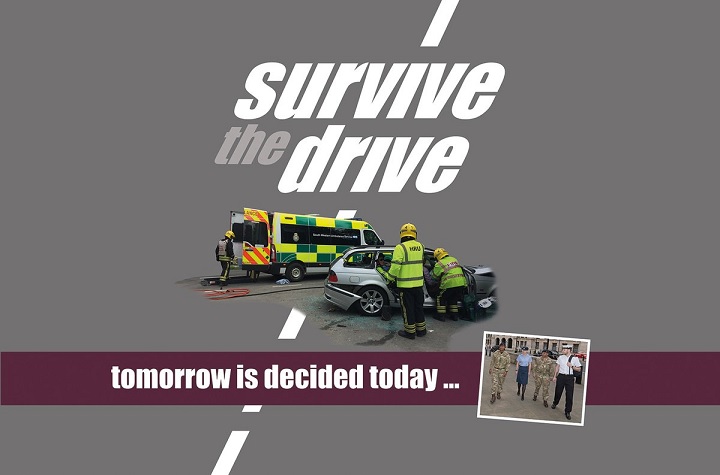
A new road safety initiative is being piloted at military bases in the south west on the back of figures suggesting army personnel are ‘111% more likely to die as a result of a road traffic collision’.
‘Survive the Drive’ has been developed by a host of organisations*, including Devon & Somerset Fire and Rescue Service (DSFRS), and is based on the Learn2Live theatre style presentation.
It comprises a mix of films featuring armed services personnel who have been involved in a road traffic collision, as well as live speakers who share their own personal experiences.
Topics covered during the session include driving while tired, drink-driving, using a mobile phone, speeding and not wearing a seatbelt.
DSFRS hopes the initiative will lead to an understanding that driving is one of the biggest risks armed forces personnel face – and that small changes in behaviour can lead to a reduction in road collisions.
Dan Lester, education and road manager for DSFRS, said: “The armed forces are statistically more at risk of a RTC than their civilian counterparts. So we are hoping to reduce that figure by giving them vital information to keep them safe behind the wheel. It is a great collaboration with the armed forces.”
In December 2018, the ‘Survive the Drive’ team presented at Stonehouse Barracks in Plymouth, speaking to Royal Marines.
Simon Roles, captain in the Royal Marines, said: “The presentation and messages are invaluable and humbling at the same time.
“Road safety is important as we have a duty of care to the people we manage. It is also vital for the military capability deployed that they see and hear the raw account that the blue light services and civilians have put across to us.”
*Survive the Drive has been developed by a consortium including DSFRS, the charity SAFE South West, Dorset & Wiltshire Fire & Rescue Service, Devon County Council Road Safety and the Ministry of Defence – Defence Safety Authority.
As a former Q.M , M.T.O & DELTA Theory Test invigilator with the UK Land Forces, along with being a driving trainer, my experience is that the British Military is in general more interested in box ✔️ than looking at the general skills taught or learned?
The average military driver is a danger to themselves & others, due to the ‘rote method’ of the training.
That is not to say that there isn’t good drivers in the UK Services. It’s just that they will be the exception rather than the rule…..
Sandy Allan, Aberdeen
--5
Some further information on this subject – a bit old perhaps but gives an insight into this subject?
https://assets.publishing.service.gov.uk/government/uploads/system/uploads/attachment_data/file/296056/20140327-LTA_deaths_in_the_UK_regular_Armed_Forces_2013_-U.pdf
Does anyone know of any studies which shows the types/causes of collisions which service personnel are involved in which may indicate if any of the anecdotal theories in this thread are on the right lines?
Nick G Hughes, Preston
0
The statistics only mention fatalities, not collisions per se, so does that mean that they do not have any more collisions than usual, but that they are 110% more likely to be killed when they do, in which case perhaps ex-army personnel choose not to wear their seabelts possibly.
Hugh Jones
0
Could the reason for the higher figures be that they are a population of people whose predisposition, reinforced by the best military training in the world, gives them a propensity to take higher risks?
If that is so, then a solution would be to train them to be more risk-averse – and thus, less effective in their day jobs.
Another solution might be to fix the road system design so that it can more safely accommodate the reasonably expected range of human behaviours present in its legitimate customer base.
Charles, Birmingham
--3
The implication – as I read it – was that, all things being equal, army personnel are more at risk than non-army personnel who similarly may own a car, are out with their mates and are in the same age group.
Hugh Jones
+1
Simply because they’re young lads, able to afford a car, often out with their mates. You don’t get many grannies and old duffers serving in the armed forces.
Stats from BRAKE:
Drivers aged 16-19 are a third more likely to die in a crash than drivers aged 40-49
One in four 18-24 year olds (23%) crash within two years of passing their driving test
Young male drivers are involved in many more crashes than young female drivers
R Brunsdon
0
…because those who have come back from operations, especially operations that have involved considerable risk, feel invincible?
David Weston, Corby
--2
“..111% more likely to die as a result of a road traffic collision’” Any theories as to why, anybody?.
Hugh Jones
0